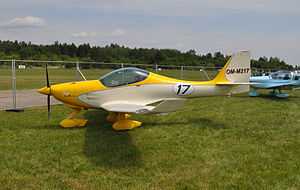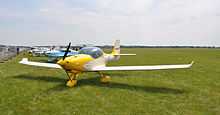B&F Fk14 Polaris
| Fk14 Polaris | |
|---|---|
 | |
| Role | Two seat sports ultralight |
| National origin | Germany |
| Manufacturer | B&F Technik Vertrieb gmbh, Speyer |
| First flight | May 1999 |
| Status | In production |
| Number built | 90 by September 2008 |
| Unit cost | |
The B&F Fk14 Polaris, also called the FK-Lightplanes FK14, is a single-engine, low-wing ultralight aircraft which seats two side by side. Designed in Germany in the late 1990s, it remains in production.[1]
The Cirrus SR Sport, simply called the Cirrus SRS, was a version of the B&F Fk14 Polaris intended to be marketed as a light-sport aircraft by US-based aircraft manufacturer Cirrus Aircraft, and was promoted from 2007 until its suspension in 2009 during the economic crisis.
Design and development
Design of the B&F Fk14 Polaris, sometimes known as the Funk Fk 14 Polaris but not by its makers,[2] began in 1998. It first flew in May 1999 and started in production the next year. It is a low-wing, single-engine ultralight, with enclosed accommodation for two seated side by side. Its largely glass fibre (carbon on the Fk14B variant) wing is mostly of parallel chord but toward the tips, where short span aluminium ailerons occupy the trailing edges, the leading edge is swept. Electrically operated Fowler flaps are fitted. Four flap settings are available: +0°, +10°, +20° and +32°. The wingtips incorporate short winglets. The fin and rudder are gently swept; the rudder is deep, reaching the lower fuselage line and moving in a cutout between the elevators. These rear flying surfaces are mass-balanced. The Polaris has spring-trimmed controls.[3]
Until 2007 B&F offered a choice of steel framed or monocoque fuselage structures, but since then have produced only the latter. The occupants sit side by side under a single piece, forward-hinged canopy. The standard undercarriage is of tricycle configuration, though a conventional undercarriage is an option. The main legs are fuselage mounted spring cantilevers and the nosewheel is steerable. All wheels are spatted. The Polaris may be fitted with a ballistic parachute (BRS 5) as an option.[3]
There is a choice between two of the Rotax 912 series flat four-cylinder engines: either the 60 kW (80 hp) 912 UL or the 74 kW (99 hp) 912 ULS may be fitted. These drive three-blade, ground adjustable pitch propellers.[3]
Cirrus SRS
At Airventure 2007, the USA aircraft manufacturer Cirrus Design announced that they intended to market a version of the Fk14 as the Cirrus SR Sport, also known as the Cirrus SRS. First deliveries were initially planned for mid-2008.[4] In early 2008 the company began taking orders for delivery, with a $5,000 deposit required.[5]
Cirrus Design's then-CEO, Alan Klapmeier, announced in October 2008 that, due to the economic situation and resulting lack of demand for Cirrus aircraft, the company was moving to a three-day work week and that the introduction of the Cirrus SRS had been delayed until 2009, due to lack of demand in the light sport aircraft market sector.[6][7]
In April 2009 the company announced that it was suspending the Cirrus SRS light sport aircraft project, citing economic conditions, and that the project required development of the airplane and an expanded flight-training strategy. They also stated that with time the LSA rules are expected to change and allow Cirrus to build an LSA with a broader mission profile.[8]
Operational history
The 90th Polaris was completed in September 2008. In mid-2010, the European registers (excluding Russia) listed 72 aircraft.[9]
Variants

- Fk14
- Standard version.
- Fk14B
- Introduced about 2003, with new carbon fibre wing, greater range, improved access with greater canopy opening angle; baggage space behind seats; altered engine cowling.
- FK14 B2 LeMans
- Version with the bubble canopy replaced by two separate "roadster-style" windshields mounted in a single frame.[1]
- Cirrus SRS
- Under development by Cirrus Design Co. in the US, this meets local LSA rules: test bed has flown.
Specifications (Fk14 Polaris)
Data from Jane's All the World's Aircraft 2010/11[3]
General characteristics
- Capacity: two
- Length: 5.69 m (18 ft 8 in)
- Wingspan: 9.04 m (29 ft 8 in)
- Height: 2.00 m (6 ft 7 in)
- Wing area: 9.40 m2 (101.2 sq ft)
- Empty weight: 284 kg (626 lb) including parachhute
- Max takeoff weight: 472.5 kg (1,042 lb)
- Fuel capacity: 65 L (15.8 imp gal, 19.0 US gal) standard
- Powerplant: 1 × Rotax 912ULS 4- cylinder flat four, air and water cooled, 73.5 kW (98.6 hp)
- Propellers: 3-bladed Junkers or Duc, ground adjustable pitch/
Performance
- Cruising speed: 243 km/h (151 mph; 131 kn) at 75% power
- Stall speed: 64 km/h (40 mph; 35 kn)
- Never exceed speed: 290 km/h (180 mph; 157 kn)
- Range: 648 km (403 mi; 350 nmi)
- g limits: +4/−2
- Rate of climb: 7.5 m/s (1,480 ft/min)
References
- ↑ 1.0 1.1 1.2 Bayerl, Robby; Martin Berkemeier; et al: World Directory of Leisure Aviation 2011-12, page 50. WDLA UK, Lancaster UK, 2011. ISSN 1368-485X
- ↑ "Fk lightplanes - History". Retrieved 2011-01-09.
- ↑ 3.0 3.1 3.2 3.3 Jackson, Paul (2010). Jane's All the World's Aircraft 2010-11. Coulsdon, Surrey: IHS Jane's. p. 228. ISBN 978-0-7106-2916-6.
- ↑ "The Secret's Out". 2007-07-23. Retrieved 2007-07-23.
- ↑ Cirrus Taking Orders for SRS, Flying Magazine, Vol. 135., No. 5, May 2008, p. 26
- ↑ Niles, Russ (October 2008). "Cirrus Goes To Three-Day Week". Retrieved 2008-10-27.
- ↑ Duluth News Tribune (October 2008). "Cirrus CEO: Tax break could mean better sales". Retrieved 2008-10-27.
- ↑ Grady, Mary (April 2009). "Cirrus LSA Program On Hold". Retrieved 2009-04-24.
- ↑ Partington, Dave (2010). European registers handbook 2010. Air Britain (Historians) Ltd. ISBN 978-0-85130-425-0.
External links
| Wikimedia Commons has media related to B&F FK14. |
| ||||||||||
| ||||||
| ||||||||||||||||||||||